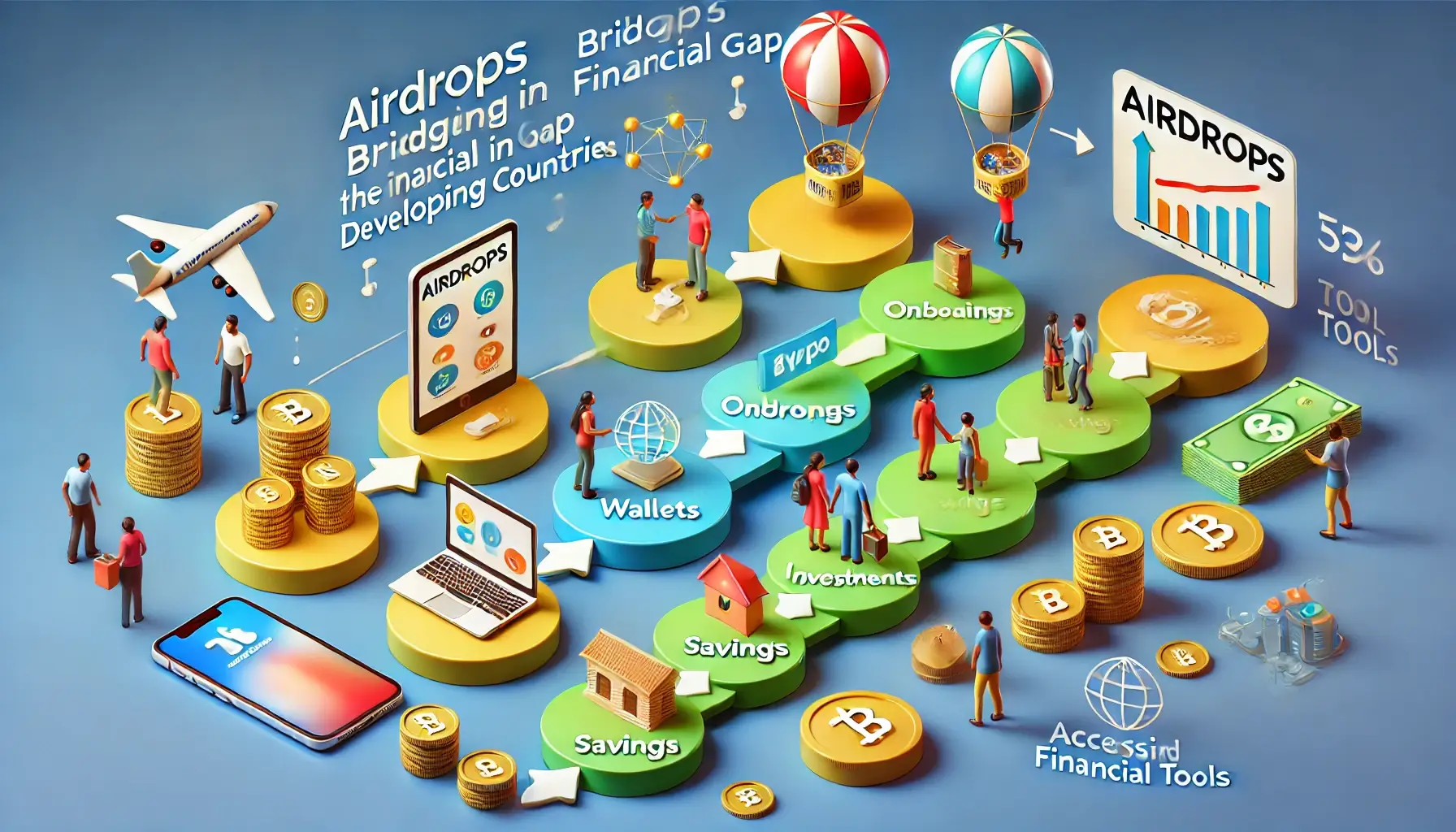Cryptocurrency is growing in popularity worldwide, but emerging markets face unique challenges that make adoption difficult. Many people in developing regions lack access to traditional banking, reliable internet, or the financial literacy needed to use cryptocurrencies effectively. Airdrops help solve these issues by providing free tokens, thus breaking barriers and making cryptocurrency more accessible in these regions.
This article will explore how airdrops are bringing cryptocurrencies to new users in developing regions. They are providing a way to participate in the global digital economy without many of the usual challenges.
1. What Are Airdrops, and Why Are They Effective in Emerging Markets?
Airdrops are marketing tools that distribute free tokens to users, often as promotions or rewards. For people in emerging markets, airdrops offer a valuable chance to acquire cryptocurrency without spending money or handling complex financial processes. This is crucial in regions where traditional finance is limited.
Airdrops lower the barriers to cryptocurrency entry. In developing countries, where financial services are often unavailable, airdrops give people a risk-free way to explore digital assets. This direct access helps users learn about cryptocurrencies by using tokens in a practical, hands-on way.
For example, people in regions like Sub-Saharan Africa or South Asia are now using airdropped tokens to buy products or save. They are doing this without needing access to traditional banks. In these regions, airdrops often serve as the first encounter with cryptocurrency, offering an entry point into the broader crypto ecosystem.
2. Airdrops Encourage Financial Inclusion
One of the major impacts of airdrops in emerging markets is financial inclusion. Millions of people are unbanked, lacking access to the traditional banking system. Cryptocurrencies, with the help of airdrops, are bridging this gap by providing financial services directly through digital wallets.
Key Benefits of Airdrops for Financial Inclusion:
- Free Access to Crypto: Airdrops let users receive tokens without a bank account or credit card.
- Learning Opportunity: Users can receive tokens, experiment with crypto, and better understand how digital assets work.
- Access to Financial Tools: Once they receive tokens, users gain access to peer-to-peer lending, remittances, and savings tools—all without banks.
Airdrops are bypassing traditional banking and providing new financial opportunities. They are making services available to those who have had limited access until now.
3. Real-World Examples of Airdrops in Emerging Markets
Several crypto projects are targeting emerging markets to drive adoption using airdrops. Let’s explore two examples where airdrops are making a difference.
Example 1: Celo’s Airdrops in Africa
Celo, a mobile-first blockchain, focuses on boosting crypto adoption in Africa. By airdropping cUSD, a stablecoin pegged to the US dollar, Celo provides users in developing countries with a stable currency. This helps them deal with local currency devaluation and highlights the value of cryptocurrencies.
Celo partners with local community groups to promote airdrops. They make the process simple, ensuring more people in Africa can join the digital economy. This approach lowers the barriers for new users and encourages them to adopt cryptocurrency.
Example 2: Stellar’s Airdrops for Remittances in Latin America
Stellar uses airdrops to drive crypto adoption in Latin America. Stellar partners with money transfer services to airdrop XLM tokens directly to users’ wallets. These tokens can then be used for remittances a service vital to many people in developing countries who receive money from family abroad.
Airdrops from Stellar reduce remittance costs and make the process faster. This benefits people in emerging regions and drives adoption by showing real value through practical use.
4. Incentivizing Participation in the Local Economy
Airdrops are also encouraging people in emerging markets to participate in their local digital economy. By providing tokens that hold real value, airdrops are motivating users to interact with crypto platforms and decentralized applications (dApps).
Airdrops Encouraging Local Engagement:
- Earning and Spending: Users earn tokens and then spend them on goods or services within the local ecosystem.
- Supporting Local Projects: Tokens are used to support local businesses that accept crypto payments, promoting growth.
- Gamification of Crypto Education: Users earn tokens by learning about blockchain technology, which makes the education process more engaging. This approach appeals particularly to younger people.
For example, projects in India are using airdrops to incentivize users to support local dApps. Users receive tokens for interacting with these applications, which leads to a stronger, more vibrant digital economy.

5. Challenges Facing Airdrops in Emerging Markets
While airdrops have many benefits, they also face challenges, particularly in emerging markets. Access to is still limited in some areas, making it hard for users to claim tokens or use dApps. also remains a challenge, as some people find the process intimidating.
How Projects Are Addressing These Challenges:
- Mobile-First Platforms: Projects like Celo use mobile-first approaches to reach users with just a smartphone.
- Community-Based Education: Partnering with local groups helps educate users about crypto and the value of airdrops.
- Simplified Onboarding: Many platforms now have easy onboarding processes to make participation more accessible.
These efforts are helping ensure that airdrops can reach people, even in areas with limited resources.
6. The Future of Airdrops in Emerging Markets
As cryptocurrencies continue to grow, airdrops will become even more important in driving adoption in emerging markets. We expect airdrops to be more targeted and localized, meeting the specific needs of developing communities.
Future Trends to Watch:
- Localized Token Airdrops: More projects will airdrop local currency-pegged tokens to help combat inflation.
- Integration with Microfinance: Airdrops will integrate into microfinance programs, offering tokens for loans or savings.
- Partnerships with NGOs: Collaborating with NGOs will help bring airdrops directly to underserved communities, combining crypto with social benefits.
These trends will push airdrops further, bringing value to regions that have the most to gain.
Conclusion
Airdrops are playing a key role in bringing to emerging markets. By providing free tokens, airdrops reduce financial barriers and help introduce cryptocurrencies to new users. Projects like Celo and Stellar are driving adoption by addressing specific challenges, like inflation and remittance costs.
As the crypto space expands, airdrops will remain crucial for spreading financial inclusion. They will help developing regions participate in the global digital economy and create new opportunities for financial growth and digital inclusion.
For more insights into how airdrops are helping emerging markets, visit our Crypto Adoption Guides.
Stay Updated
For the latest updates on crypto adoption in emerging markets and airdrop opportunities, follow us on:
Stay informed with the latest crypto insights at FreeCoins24.io.
Special Offer
Want to trade tokens earned from airdrops? Sign up on Bybit today and enjoy up to $30,000 in deposit bonuses. Trade with confidence on a trusted platform.

















